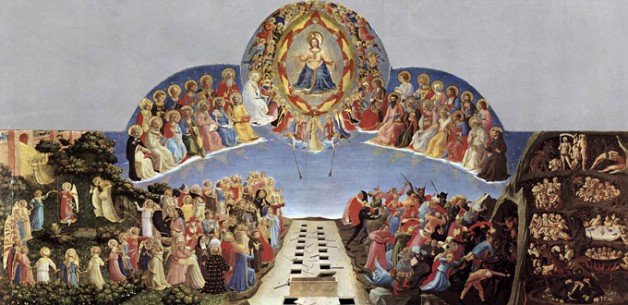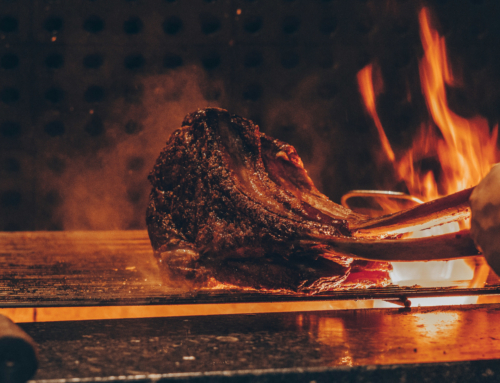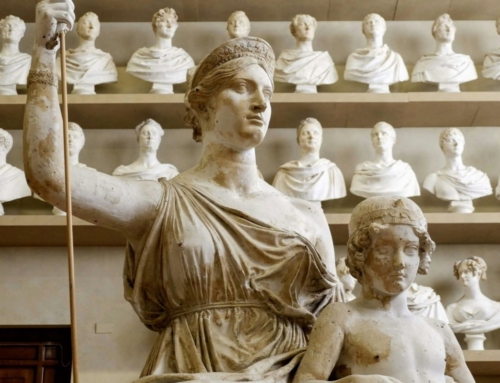I also saw the holy city, a new Jerusalem, coming down out of heaven from God, prepared as a bride adorned for her husband. I heard a loud voice from the throne saying, “Behold, God’s dwelling is with the human race. He will dwell with them and they will be his people and God himself will always be with them (as their God)… It gleamed with the splendor of God. Its radiance was like that of a precious stone, like jasper, clear as crystal. It had a massive, high wall, with twelve gates where twelve angels were stationed and on which names were inscribed, (the names) of the twelve tribes of the Israelites. There were three gates facing east, three north, three south, and three west. The wall of the city had twelve courses of stones as its foundation, on which were inscribed the twelve names of the twelve apostles of the Lamb. The one who spoke to me held a gold measuring rod to measure the city, its gates, and its wall. The city was square, its length the same as its width. He measured the city with the rod and found it fifteen hundred miles in length and width and height. He also measured its wall: one hundred and forty-four cubits according to the standard unit of measurement the angel used. The wall was constructed of jasper, while the city was pure gold, clear as glass.
—Revelation 21:2-3, 11-18
At last in Chapter 21 the Bride of the Lamb makes her appearance, the New Jerusalem coming down out of heaven.
The chief reward of heaven is of course God himself: nothing could ever be so marvelous or wonderful as Happiness, Love, Beatitude, Being, and Goodness Himself.
The description of the city as seen in the vision is packed with symbolic detail. The precious stones symbolize not only its excellence and preciousness, but its sacredness and its scale—encompassing of all Israel. The Church is Israel in the New Covenant. The passage evokes, among other things, the breastplate of decision in Exodus 28, on which were twelve precious stones. Twelves are everywhere, symbolizing all Israel, and also the Twelve Apostles who are its foundations. Measuring the city with the rod should remind us of the vision of the perfect Jerusalem towards the end of Ezekiel. The ideal Israel and Temple and worship of God that Ezekiel could only see from far off and yearn for is fulfilled beyond all expectations in the heavenly city.
The detail that the city is the same in length and width and height may seem odd—who ever makes a cubical city? But the attentive reader of the Old Testament will recall that this is a reference to the Holy of Holies of Solomon’s Temple (I Kings 6). The account of the old Temple has many prophetic details when we go back to it and see it with the prophetic knowledge we have learned from the Book of Revelation.
There is no Temple in the City because it is a temple—the whole thing is the Holy of Holies, or so its architecture tells us. We are also told the Temple is the Lord God Almighty and the Lamb. This would seem to be an identification—not pantheism, but perhaps we should say the Lamb becoming one flesh with his Bride.
The dimensions are made up of twelves and thousands, meaning “Israel” and “very large.” It is not that Israel is done away with and replaced by the Church. Rather, there is a continuity of the People of God from the Old Testament to the New as the gentiles are grafted onto the olive tree of Israel (Romans 11:11-24). The Church includes all those who have sanctifying grace and ultimately all those brought by God’s grace to the glory of heaven.
In chapter 22, the river flowing from the throne and the trees recall the vision in the latter part of Ezekiel. There the water flowing from the Temple corresponds to the blood and water flowing from the side of Christ on the Cross. Examine both the Ezekiel passage and a typical crucifix, and you will see that the wound matches the position in Ezekiel’s description—Jesus is the Temple.
One last question that one may ask about the New Jerusalem in Chapter 21 and 22: “Where are all the people?”
The answer is that we just read the description of them. The buildings of the city are a symbol, as we should know by now! As St. Peter says,
Come to him, a living stone, rejected by human beings but chosen and precious in the sight of God, and, like living stones, let yourselves be built into a spiritual house to be a holy priesthood to offer spiritual sacrifices acceptable to God through Jesus Christ.
—I Peter 2:4-5
Finally, we have no better way of closing our tour of the Book of Revelation than the joyous plea of love with which the Book itself ends:
The Spirit and the Bride say, “Come.” Let the hearer say, “Come.”
The one who gives this testimony says, “Yes, I am coming soon.”
Amen! Come, Lord Jesus!
Image: Fra Angelico, Last Judgment







